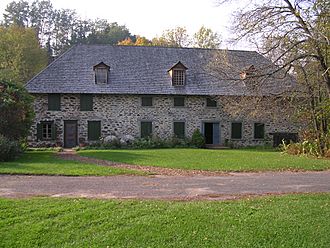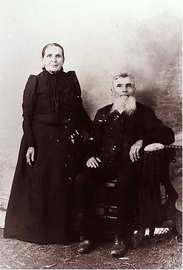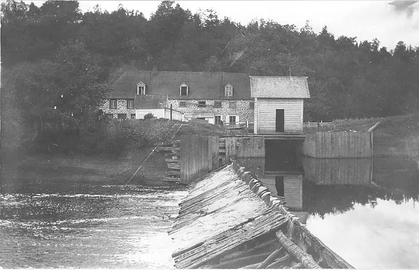Moulin du Portage facts for kids
Quick facts for kids Moulin du Portage |
|
|---|---|

Moulin du Portage in Lotbinière
|
|
| General information | |
| Type | Water-powered grinding mill |
| Classification | Heritage building (Immeuble patrimonial) 30 September 1964 |
| Address | 1080, rang Saint-François |
| Town or city | Lotbinière, Quebec |
| Country | Canada |
| Coordinates | 46°33′16″N 71°58′13″W / 46.554561°N 71.970168°W |
| Completed | 1816 |
| Technical details | |
| Material | Stone masonry |
| Floor count | 2 ½ |
The Moulin du Portage is an old flour mill in Quebec, Canada. It used water power to grind grain. This mill is a special heritage building. A fire destroyed most of it in 1988, but its strong stone walls survived. It was rebuilt just like it was before. Today, it's a place where people can enjoy shows and events.
Contents
Where is the Moulin du Portage?
The mill sits in a deep valley. It's right by a bend in the Chêne River. You can find it in Lotbinière, a town in the Chaudière-Appalaches region of Quebec.
It's west of Lotbinière village. A 4.2 km hiking trail connects it to Leclercville village. Trees hide the mill a bit. A small path leads from the main road to the mill. The mill and its land are protected as a heritage site. There's also an old archaeological site here.
What Does the Mill Look Like?
The mill you see today was rebuilt after the 1988 fire. Only the stone walls were left. It's a long, rectangular building. It has two main floors and an attic with sloped ceilings.
Its walls are made of rubble stone. This stone is set in mortar on strong stone foundations. The roof is made of wood. It's covered with cedar shingles. The mill has rectangular windows. They have small glass panes. The windows and doors are placed in an uneven way.
How the Mill Used Water Power
The mill used to get its power from the river. Water flowed through a canal to a large water wheel. This wheel was called an "undershot" wheel. It turned when water flowed under it.
Later, a dam was built across the river. This dam helped send more water to the mill. Around the early 1900s, the water wheel was replaced. New machines called turbines were installed instead.
History of the Portage Mill
The Moulin du Portage has a long and interesting history. It played an important role in the local community for many years.
Early Mills and Seigneurs
In 1672, a French official named Jean Talon gave the land of Lotbinière to René-Louis Chartier de Lotbinière. René-Louis was the first "seigneur" (lord) of the area. He kept some land for himself, which was common then.
The first flour mill in Lotbinière started in 1693. It was a "banal mill." This meant the seigneur had to build it. Local people had to bring their grain there to be ground. They also had to pay a fee called the droit de banalité. A new mill was built in 1769. This was replaced by the current Moulin du Domaine in 1799.
Building the Moulin du Portage
By the early 1800s, the main mill had a problem. The water supply often dropped in summer. This made it hard to grind enough grain. So, the fourth seigneur, Michel-Eustache-Gaspard-Alain Chartier de Lotbinière, decided to build a second mill.
Construction of the Moulin du Portage began in 1815. It was built on the banks of the Chêne River. Louis Lemay, a carpenter, built the mill's machinery. The Moulin du Portage was also a banal mill. In the 1800s, the mill, the seigneur's house, and the church were the main parts of the community.
Challenges and Changes Over Time
The Moulin du Portage operated throughout the 1800s. But it often had problems with its water supply. The mill didn't make much money. Even when it was also used as a sawmill for a few years, it struggled.
Big floods in spring often damaged the mill. In 1854, the miller Télesphore Demers and his wife Éloïse Beaudet lived and worked at the mill. Their family continued to run it. But in 1929, a rush of water destroyed the machinery. The seigneur decided not to fix it. Water mills couldn't compete with bigger, industrial flour mills anymore. Around 1945, electricity came to the countryside. The mill reopened from 1947 to 1952. It was used to grind animal feed.
Restoration and Rebirth
After being abandoned, the mill was neglected. It was also damaged by vandals. Then, a group of citizens stepped in. They got money from the Quebec Ministry of Cultural Affairs. The Moulin du Portage was officially named a heritage building on September 30, 1964.
In 1979, the "Société des Amis du Moulin du Portage" (Friends of Portage Mill Association) was formed. They spent three years restoring the mill. It opened to the public as an auditorium. But on May 17, 1988, a fire destroyed most of the building. Only the four stone walls remained. The Friends' Association worked hard again. They got money to rebuild it. They followed the original plans exactly. Five years later, the mill reopened its doors.
Gallery




